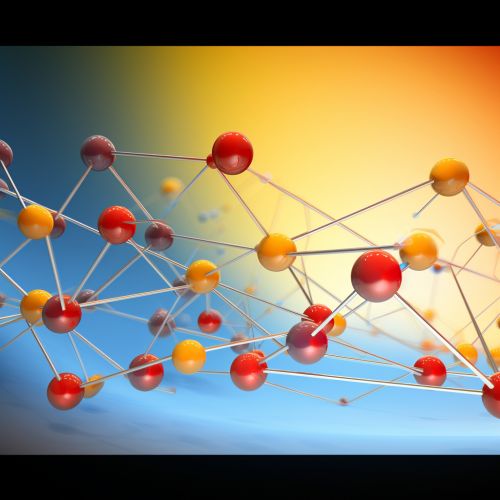Transition state
Overview
The transition state is a crucial concept in the field of chemical kinetics, which deals with the rates at which chemical reactions occur. It represents an intermediate stage in a chemical reaction where the reactants have reached the highest energy point on the reaction path, and the formation of products is imminent. The transition state is not a stable species and cannot be isolated or directly observed, but its properties can be inferred from experimental data and theoretical calculations.
Concept and Definition
The transition state, also known as the activated complex, is a high-energy configuration of the reactant molecules during a chemical reaction. It is the point at which the old bonds are at their weakest and the new bonds begin to form. The transition state is often represented by a peak in a potential energy diagram, which plots the energy of the system as a function of the reaction coordinate.
The concept of the transition state was first proposed by Henry Eyring and Michael Polanyi in the 1930s as part of the transition state theory, which provides a detailed description of the rates of chemical reactions. According to this theory, the rate of a reaction is proportional to the number of reactant molecules that have enough energy to reach the transition state.
Characteristics of the Transition State
The transition state has several distinctive characteristics. First, it is a state of highest energy along the reaction path, meaning that it is less stable than either the reactants or the products. Second, it is a transient state, existing for only a brief moment during the reaction. Third, it is a state of maximum disorder, with the reactant molecules in a highly strained and distorted configuration.
The transition state is often depicted as a saddle point on the potential energy surface, with the energy increasing in all directions away from the transition state. This reflects the fact that the transition state is a point of instability, where any small perturbation will cause the system to move away from the transition state and towards either the reactants or the products.
Determination of Transition State Properties
Despite its transient nature, the properties of the transition state can be determined indirectly through a variety of experimental and theoretical methods. Experimentally, the transition state can be probed using techniques such as femtochemistry, which involves the use of ultrafast laser pulses to monitor the progress of a reaction on the timescale of femtoseconds (10^-15 seconds).
Theoretically, the properties of the transition state can be calculated using quantum chemical methods. These calculations involve solving the Schrödinger equation for the system of interest, which provides a detailed description of the electronic structure of the molecules involved in the reaction. The transition state is identified as the point of highest energy along the reaction path, which can be determined by following the path of steepest ascent from the reactants to the products.
Role in Reaction Rates
The transition state plays a central role in determining the rate of a chemical reaction. According to the transition state theory, the rate of a reaction is proportional to the number of reactant molecules that have enough energy to reach the transition state. This is expressed mathematically by the Arrhenius equation, which relates the reaction rate to the activation energy, the energy barrier that must be overcome to reach the transition state.
The transition state theory also provides a way to calculate the activation energy from the properties of the transition state. This is done by comparing the energies of the transition state and the reactants, and taking into account the statistical factors that reflect the number of ways the reactants can rearrange to form the transition state.
Applications of Transition State Theory
The transition state theory has wide-ranging applications in the field of chemistry. It is used to predict the rates of chemical reactions, to design catalysts that can lower the activation energy and increase the reaction rate, and to understand the mechanisms of complex reactions.
In addition, the transition state theory has been extended to other areas of science, including physics, biology, and materials science. For example, in biology, the concept of the transition state is used to understand the action of enzymes, which are biological catalysts that speed up chemical reactions in living organisms. In materials science, the transition state theory is used to study phase transitions and other processes that involve the rearrangement of atoms or molecules.
See Also
- Chemical kinetics
- Potential energy surface
- Arrhenius equation
- Quantum chemistry
- Femtochemistry
- Enzyme kinetics


